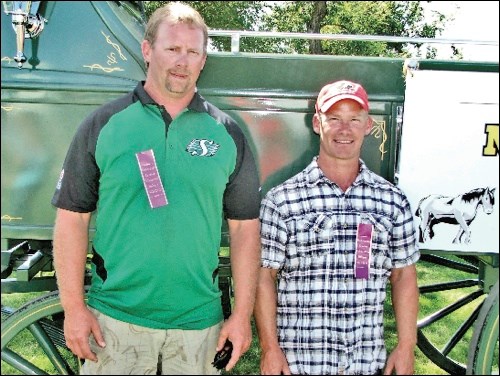"Canada is the place to be."
It was with those exact words in mind that Camille Nachtegaele returned home to Belgium from a season in Canada in the first years of the 1900s. He had just spent some time working for a Belgium family in Manitoba prior to making the biggest decision in the Nachtegaele family history.
It didn't take long until he was back with his brother Louis, in 1906, to settle on their own piece of land in the Belgium Flats, near Redfield. The land was granted to them by the government under the Dominion Lands Act (also known as the Homestead Act, because of the American program). The act gave 160 acres (65 ha) for free, the only cost to the farmer being a $10 administration fee, to any male farmer who agreed to cultivate at least 40 acres and build a permanent dwelling within three years.
Following the two first brothers came Gustaaf and Leon Nachtegaele, in 1911, to start the farm that is now having it's 100th anniversary celebrated by the family who have owned and worked the farm for a full century.
When the two younger brothers arrived in Canada 100 years ago, they brought with them a precious gift from their father: 11 registered Belgian horses - eight mares and three stallions, to be divided among the four brothers: two mares for each brother and the stallions to be rotated around.
Not being able to benefit from the homestead program his brothers had used earlier, Gustaaf had to buy his farm. He bought his first quarter of land for $4,000. It was to this land he arrived with his horses and his hopes for a brighter future. According to Joyce Heidel, a granddaughter to the original settler, those were the first Belgium horses to be introduced to the region.
"They were an important addition, not only for the heavy land-breaking and farming work, but as an income supplement for the family."
The eldest member of the Nachtegaele family - Gustaaf, 84 years old - explains his great-grandfather would take the stallions to service the mares of the surrounding farms. "Belgian horses are huge, sturdy and yet gentle horses, very desirable attributes for the conditions they faced here at that time. So, by doing that, he would make some extra money and help with the farm finances."
To illustrate how strong Belgian horses are, George Nachtegaele, 74, tells a story about their forefathers tying the horses to a secured cart fully-loaded with wheat and making them pull until they broke the cart apart.
"These horses can pull," he says.
Alan Nachtegaele, also a grandson of Gustaaf and father to the current farmers, says the horses lost their relevance for the region with the advent of the first tractors. "The last horses were sold in the early '40s." Joyce remembers her mother saying "she had tears in her eyes when she saw the horses being hauled away."
The modern farmhouse is still located at the same spot where the original dwelling was 100 years ago, northwest of North Battleford. And the Nachtegaele farm has been farmed by the same family for a century, now being run by its fourth generation, brothers Keith and Dwaine Nachtegaele. It seems likely that, with more than 200 members directly linked to Gustaaf's family line, the Nachtegaele family will have plenty of material for 100 more years of stories.




